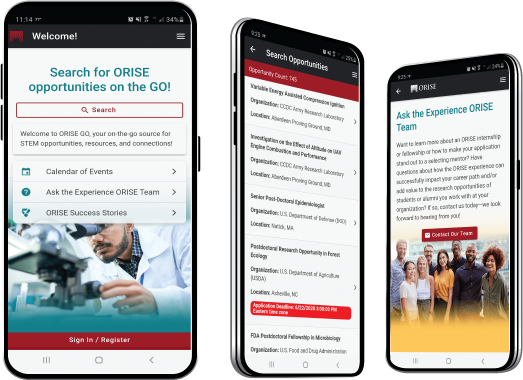Landsat/Sentinel-2 satellite Water Quality Products and Integration of Landscape Change
A complete application consists of:
- An application
- Transcripts – Click here for detailed information about acceptable transcripts
- A current resume/CV, including academic history, employment history, relevant experiences, and publication list
- Two educational or professional references
All documents must be in English or include an official English translation.
If you have questions, send an email to EPArpp@orau.org. Please include the reference code for this opportunity in your email.
A postgraduate research training opportunity is currently available at the U.S. Environmental Protection Agency (EPA)’s Office of Research and Development (ORD)/National Exposure Research Laboratory (NERL). This appointment will be serve with the Exposure Methods & Measurement Division (EMMD) in Research Triangle Park, NC.
EMMD develops, evaluates, applies methods, and performs laboratory and field studies to collect and analyze exposure related data. In addition, it develops new measurement methods, and evaluates sensors including remote sensing technologies and applications. Research involves applying advanced monitoring technology to assess land cover change, terrestrial and aquatic vegetative structure, and water color algorithm development at a variety of scales.
This research project is part of a larger collaborative effort between the U.S. EPA, NASA, NOAA, and USGS to provide an approach for mainstreaming satellite ocean color capabilities into U.S. fresh and brackish water quality management decisions (see http://bit.ly/1MV7WHT and www.epa.gov/cyanoproject). The overarching project goal is to support the environmental management and public use of U.S. lakes, reservoirs, and estuaries by providing the capability to detect and quantify cyanobacteria blooms using satellite data records.
Research activities will focus on water quality algorithm development and linking impacts of landscape change to bloom events.
This training opportunity will involve the following activities:
- Developing/refining and validating algorithms which estimate chlorophyll a and TSS concentrations of lake and estuarine environments from spectral data retrieved from USGS Landsat 8 and ESA Sentinel 2 satellites
- Assessing landscape metrics contributig to freshwater system health/degradation. One component assessed will be riparian buffer metrics which include crown closure, slope, percent impervious surface, human use index – all of which will provide an overall Buffer Quality Index
- Integrating landscape change (cover type and vegetative) with cyanobacteria bloom events
This research project is on the cutting edge of water quality monitoring and applied satellite operations.
The research participant will interact with multiple EPA, NASA, NOAA, and USGS personnel involved in a broad research effort addressing various issues related to monitoring harmful and nuisance algal blooms nationally. He/she will enhance skills in applied satellite remote sensing for cyanobacteria detection and riparian buffer analysis. The participant will have the opportunity to contribute as an author on peer-reviewed manuscripts, if he/she desires.
This program, administered by ORAU through its contract with the U.S. Department of Energy to manage the Oak Ridge Institute for Science and Education, was established through an interagency agreement between DOE and EPA.
Applicants must have received a master’s degree in aquatic ecology, algal ecology, marine ecology, ocean optics, landscape or spatial ecology, forestry, natural resources, soil science (wetland/agriculture emphasis) or a related field within five years of the desired starting date, or completion of all requirements for the degree should be expected near the starting date. Experience in computer coding language (e.g. MATLAB, Python, R, or IDL, etc.), processing digital remotely sensed data, and knowledge of different GIS packages is desired.
The appointment is full time for one year and may be renewed upon recommendation of EPA and contingent on the availability of funds. The participant will receive a monthly stipend. Funding may be made available to reimburse the participant’s travel expenses to present the results of his/her research at scientific conferences. No funding will be made available to cover travel costs for pre-appointment visits, relocation costs, tuition and fees, or participant’s health insurance. The participant must show proof of health and medical insurance. The participant does not become an EPA employee.
The mentor for this project is Blake Schaeffer (schaeffer.blake@epa.gov).

 ORISE GO
ORISE GO

The ORISE GO mobile app helps you stay engaged, connected and informed during your ORISE experience – from application, to offer, through your appointment and even as an ORISE alum!





